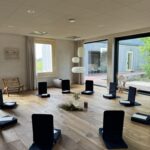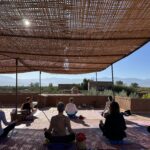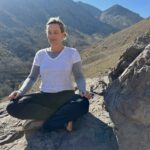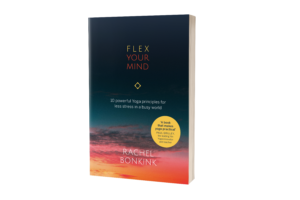This is part seven of a series exploring the ten principles of yoga philosophy, also known as the yamas and niyamas. In this series of blog posts, we explore how we can bring this fascinating ancient wisdom into our daily lives.
Whether or not you practice yoga or not is not very important. These principles are all about making this world, an even better place to live in.
Saucha, the free flow of energy
Saucha is Sanskrit and translated as ‘purity’ or ‘cleanliness’.
In other words, bringing in ‘pureness’ in your entire lifestyle. From where you live to the things you eat, to your thoughts, speech and actions.
Starting very simply with the easy interpretation of the definition and keeping your house or living environment nice and clean. It goes too far to say that a clean house will lead to a peaceful mind but the opposite of having a messy place to live in, sure doesn’t help in terms of serenity.
As with many concepts in yoga, it’s all about energy.
Can there be a free flow of energy in the space you call ‘home’ or, is there too much stuff in the way?
Cleansing your body, shatkarma
In the hatha yoga pradipika, one of the oldest texts about hatha yoga – written by Swatmarama, one is above all concerned with purifying the whole body – the stomach, the intestines, nervous system, …
Therefor shatkarma (cleansing techniques) comes first.
There’s numerous (6 to even 46 according to some sources) techniques to clean your nose, mouth, eyes, bowels, etc.
In these old texts, purity is where the hatha yoga journey starts, before proceeding with further breathing techniques and postures.
This is why you will sometimes read about hatha yoga being the science of purification. By cleansing the body from impurities, we allow for energy to flow freely and for energy blocks to be released. Consequently, creating a pathway for more balance and union in body, mind and spirit.
If ahimsa (non-violence) is the foundation of all yamas, we can consider saucha as the foundation of all niyamas. As our body and minds become clearer, the practice that follows become easier.
How about your thoughts?
Nowadays, hatha yoga is generally practiced to reduce stress, to relax, to improve health or to make our bodies stronger. Which is brilliant, as long as we keep in mind that there can be more to it.
When you practice yoga asana, there is the potential that your physical and mental states begin to increase and unfold.
Some people literally say that they have a pre and post yoga life. Especially when coming on one of my yoga retreats as there, they get a full immersion on all the aspects of yoga. On those retreats, I often zoom in on our thoughts.
On an average day, how pure would you say your thoughts are? About yourself, and others?
Imagine that you have a giant screen hanging above your head, which beams your every single thought out into the world…
Everyone around you, can see what you are actually thinking…
Would you be in trouble?
If yes, why? Because of your judging and harsh words?
Simply noticing that you have judging or angry thoughts, and not giving them any extra attention, might already help in stopping this negative rant of thoughts.
Where postures and breathing techniques help us in cleansing our bodies, meditation and mindfulness can purify us from negative emotions like hatred, greed, jealousy, envy, etc.
Purity in your yoga class
You hear the funniest things in so called ‘yoga communities’.
“I am spiritual, so I am beyond my physical body.”
“Hatha yoga is too body-minded, for me, it’s all about the mind.“
This is not what the old scriptures are telling us.
Try to sit still in meditation for 24 minutes when you have never done so before. I can assure you, you will become very aware of your body.
We can not forget about the body, and why would we? The body is important, as is the mind and the spirit. If yoga means Union, it is all about the Union of Body, Mind and Spirit.
People often get confused when ancient texts use the most bizarre words to describe our body as a decaying ‘thing’ that will never be perfectly clean.
All we need to take from this is to not have an excessive fixation with the body, or the bodies of others. But, whilst we have one, we can take incredibly good care of it.
Just breathe…
One way to take good care of our bodies is to bring more attention to our breathing. We breath when we sleep so how difficult can it be, right? And still.
Incorporating breathing techniques into your yoga asana practise can shine a completely different light on your experience.
The word that comes up when mentioning breathing in yoga is ‘Pranayama‘.
But, pranayama is not ‘just’ breathing excercises. Prana as being the life force, the life energy or the energy that animates life.
The easiest translation of pranayama is ‘controlling the breath’ but when looking at the translation of ‘ayana’, which means ‘dimension’ and not ‘control’, we can alter that definition.
Consequently, pranayama is about expanding the dimensions of prana within you.
Having this in the back of your mind, we can see the yoga postures as a practice of pranayama.
Noticing where energy flows and where it is blocked.
Synchronizing the mind, body and breath with clear attention in every single movement.
Arising thoughts are noticed but are not automatically disturbing your practice as there is full awareness on the practice and nowhere else.
Why not give that a go next time you find yourself on a yoga mat?
To Do: what are you taking in?
If you are serious about strategically developing yourself, in that case, I have a little assignment for you.
This evening, check what you took in energy wise. How ‘clean‘ and ‘pure‘ was it all?
- The air you were breathing in. Have you been outside today?
- The food you have been eating? How much of this was fresh, clean and nutritious?
- What did you read today? The news? Something educational, inspirational?
- How much time was spend on a screen? What did you watch? Was it educational? Inspirational? Fun?
- Who did you spent your day with? Positive, inspirational and kind people?
- How were the conversations you had? Was there some love and kindness involved?
- Did you have fun? Did you laugh?
If there’s any negatives or things you know are not helping you forward when it comes to living a happier and healthier life.
Make a note and figure out right here and now, how tomorrow will be different on those aspects.
Even if it’s a tiny bit better, progress is the way forward!
I hope you enjoyed what you read about saucha. If you have any questions, please don’t hesitate asking.
Namaste,
Rachel
Rachel Bonkink is not your ordinary yoga teacher.
She holds a Masters Degree in Commercial Sciences and she can look back at a strong corporate career as an operational director. She has been a life coach for over 10 years and her company is seen globally as one of the leading yoga retreat companies. From the very start of her own yoga journey, the yoga philosophy resonated more than any asana, or posture, ever did. In the past 10 years, she has read, studied and continues to follow at least two to three trainings per year to deepen her knowledge on yoga and meditation. In between her retreats, Rachel can be found by the beach in Morocco, where she writes, studies and enjoys life, doing the things that she loves the most.










Great! Thanks for sharing this useful information. I always read blogs and tips related to yoga. My family has recently moved to Albert Park, Victoria. Here I made my kids join Little Warriors Yoga Class and I am glad I did it. In just a few days, I have noticed changes in their mental and physical health. You should also send your children to yoga class.